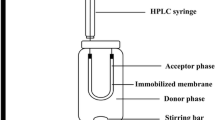Abstract
Barbiturates, especially phenobarbital, are involved in intoxication cases in Brazil and other countries. Liver tissue can be a useful alternate specimen when blood is not available (decomposition, severe fire, and exsanguination cases). Because the liver is a very complex matrix, it is essential is to eliminate potential interfering substances in this specimen before instrumental analysis of target compounds. In recent years, novel strategies for sample preparation have gained acceptance in the field of analytical toxicology. The objective of this work was to develop a gas chromatography–mass spectrometry (GC–MS) method using hollow fiber–liquid phase microextraction (HF–LPME) for determination of barbiturates (phenobarbital, secobarbital, pentobarbital, and butalbital) in liver samples. An aliquot of homogenized and acidified liver in aqueous solution (equivalent to 50 mg tissue) was submitted to extraction by the use of a 9-cm hollow fiber. The fiber was filled with eucalyptus oil in its pores and its lumen was filled with a NaOH solution (pH 13; acceptor phase). After extraction in an ultrasonic bath for 5 min, the acceptor phase was withdrawn and derivatized in the injector port of the GC–MS with trimethylanilinium hydroxide for flash methylation. A totally “green chemistry” approach of the sample extraction was obtained, because relatively large amounts of organic solvent generally used for extraction could be substituted by an essential oil used as a supported liquid membrane for HF–LPME. This method was validated and successfully applied to liver samples collected from five deceased persons with previous history of exposure to barbiturates. Phenobarbital concentrations in the liver found in these actual cases ranged from 1.3 to 16.7 μg/g.




Similar content being viewed by others
References
Margalho C, Franco J, Corte-Real F, Vieira DN (2011) Illicit drugs in alternative biological specimens: a case report. J Forensic Legal Med 18:132–135
Jones GR, Singer PP (2008) Postmortem toxicology. In: Jenkins AJ, Caplan YH (eds) Clarke’s analytical forensic toxicology. Humana Press, New Jersy, pp 139–156
Yarema MC, Becker CE (2005) Key concepts in postmortem drug redistribution. Clin Toxicol 43:235–241
Adachi N, Kinoshita H, Nishiguchi M, Takahashi M, Ouchi H, Minami T, Matsui K, Yamamura T, Yoshida S, Nishio H (2011) Determination of acephate and methamidophos in tissues: appearance of matrix effect in gas chromatography–mass spectrometry. Forensic Toxicol 29:159–162
Mihic SJ, Harris RA (2011) Hypnotics and sedatives. In: Brunton LL (ed) Goodman and Gilman′s the pharmacological basis of therapeutics. McGraw-Hill, New York, pp 457–480
Fritch D, Blum K, Nonnemacher S, Kardos K, Buchhalter AR, Cone EJ (2011) Barbiturate detection in oral fluid, plasma, and urine. Ther Drug Monit 33:72–79
Bonilha L, Collares CF, do Amaral DA, Dantas Barcia S, de Almeida Oliveira AM, Li LM (2005) Antiepileptic drugs: a study of 1028 cases registered by the Sao Paulo Intoxication Control Center. Seizure 14:170–174
Campelo EL, Caldas ED (2010) Postmortem data related to drug and toxic substance use in the Federal District, Brazil, from 2006 to 2008. Forensic Sci Int 200:136–140
Kudo K, Ishida T, Hikiji W, Usumoto Y, Umehara T, Nagamatsu K, Tsuji A, Ikeda N (2010) Pattern of poisoning in Japan: selection of drugs and poisons for systematic toxicological analysis. Forensic Toxicol 28:25–32
Abrams RC, Leon AC, Tardiff K, Marzuk PM, Santos RD (2011) Suicidal overdoses of psychotropic drugs by elderly in New York City: comparison with younger adults. Psychiatry Res 118:459–461
SAMSHA (2010) Substance Abuse and Mental Health Services Administration, Office of Applied Studies. Drug Abuse Warning Network, 2007: national estimates of drug-related emergency department visits. Rockville, MD. http://www.samhsa.gov/data/2k10/DAWN/ED2007/DAWN2k7ED.htm. Accessed July 2012
Quinones-Torrelo C, Martin-Biosca Y, Sagrado S, Villanueva-Camanas RM, Medina-Hernandez MJ (2000) Determination of amobarbital and secobarbital in plasma samples using micellar liquid chromatography. Biomed Chromatogr 14:287–292
Elisa Capella-Peiro M, Gil-Agusti M, Martinavarro-Dominguez A, Esteve-Romero J (2002) Determination in serum of some barbiturates using micellar liquid chromatography with direct injection. Anal Biochem 309:261–268
la Marca G, Malvagia S, Filippi L, Luceri F, Moneti G, Guerrini R (2009) A new rapid micromethod for the assay of phenobarbital from dried blood spots by LC-tandem mass spectrometry. Epilepsia 50:2658–2662
Saka K, Uemura K, Shintani-Ishida K, Yoshida K (2008) Determination of amobarbital and phenobarbital in serum by gas chromatography–mass spectrometry with addition of formic acid to the solvent. J Chromatogr B 869:9–15
Johnson LL, Garg U (2010) Quantitation of amobarbital, butalbital, pentobarbital, phenobarbital, and secobarbital in urine, serum, and plasma using gas chromatography–mass spectrometry (GC–MS). Methods Mol Biol 603:65–74
Samanidou V, Kovatsi L, Fragou D, Rentifis K (2011) Novel strategies for sample preparation in forensic toxicology. Bioanalysis 3:2019–2046
Flanagan RJ, Morgan PE, Spencer EP, Whelpton R (2006) Micro-extraction techniques in analytical toxicology: short review. Biomed Chromatogr 20:530–538
Pedersen-Bjergaard S, Rasmussen KE (2008) Liquid-phase microextraction with porous hollow fibers, a miniaturized and highly flexible format for liquid–liquid extraction. J Chromatogr A 1184:132–142
SOFT (2006) Society of Forensic Toxicology Inc. - forensic toxicology laboratory guidelines. http://www.soft-tox.org/files/Guidelines_2006_Final.pdf. Accessed July 2012
Lewis RJ, Johnson RD, Southern TL, Canfield DV (2003) Distribution of butalbital in postmortem tissues and fluids from non-overdose cases. J Anal Toxicol 27:145–148
Giusiani M, Chericoni S, Domenici R (2012) Identification and quantification of phenobarbital in a mummified body 10 years after death. J Forensic Sci. doi:10.1111/j.1556-4029.2012.02147.x
Cingolani M, Cippitelli M, Froldi R, Tassoni G, Mirtella D (2005) Stability of barbiturates in fixed tissues and formalin solutions. J Anal Toxicol 29:205–208
Acknowledgments
This study was supported by the Faculty of Medicine, University of Sao Paulo (LIM 40/HC-FMUSP). We acknowledge Fundação de Amparo à Pesquisa do Estado de São Paulo (FAPESP Grant No. 2009/08314-9), Conselho Nacional de Desenvolvimento Científico e Tecnológico (CNPq grant 470643/2009-9), and Coordenação de Aperfeiçoamento de Pessoal de Nível Superior (CAPES). The authors also thank Tiago Franco de Oliveira who prepared the figures.
Author information
Authors and Affiliations
Corresponding author
Additional information
This article is for the special issue TIAFT2012 edited by Osamu Suzuki.
Rights and permissions
About this article
Cite this article
Menck, R.A., de Oliveira, C.D.R., de Lima, D.S. et al. Hollow fiber–liquid phase microextraction of barbiturates in liver samples. Forensic Toxicol 31, 31–36 (2013). https://doi.org/10.1007/s11419-012-0160-7
Received:
Accepted:
Published:
Issue Date:
DOI: https://doi.org/10.1007/s11419-012-0160-7




